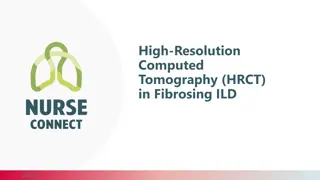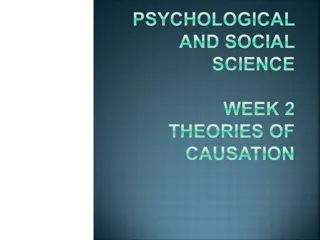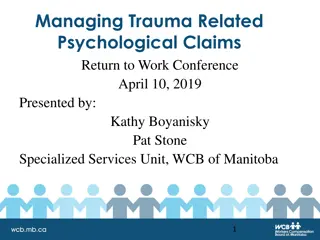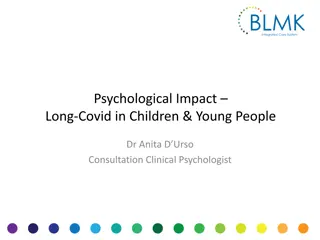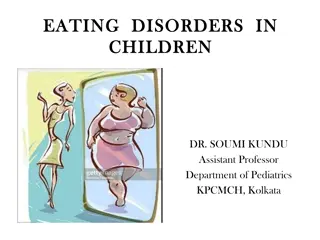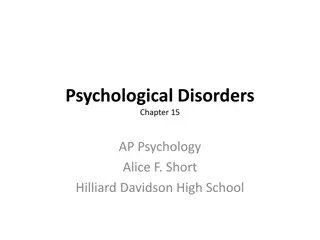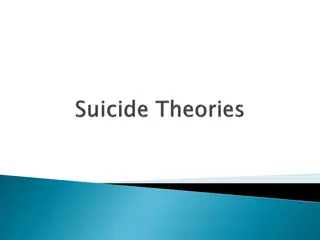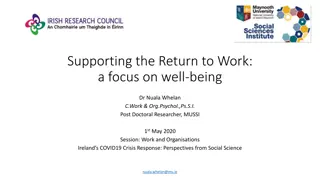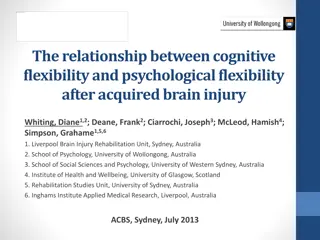Psychological Evaluation Tools and Diagnoses Overview
This collection showcases various psychological evaluation tools such as SCID-5, MMPI, Rorschach test, as well as diagnostic interviews and tests like Bender visual motor gestalt test. It also touches on reliability measures and the evolution of diagnostic manuals from DSM-II to DSM-V and ICD-10, providing a comprehensive overview of psychological assessments.
Download Presentation

Please find below an Image/Link to download the presentation.
The content on the website is provided AS IS for your information and personal use only. It may not be sold, licensed, or shared on other websites without obtaining consent from the author.If you encounter any issues during the download, it is possible that the publisher has removed the file from their server.
You are allowed to download the files provided on this website for personal or commercial use, subject to the condition that they are used lawfully. All files are the property of their respective owners.
The content on the website is provided AS IS for your information and personal use only. It may not be sold, licensed, or shared on other websites without obtaining consent from the author.
E N D
Presentation Transcript
: 7 :
interview SCID Structured Clinical Interview for DSM-5 (SCID-5) CIDI, SADS composite international diagnostic interview Schedule for Affective Disorders and Schizophrenia
MMPI Minnesota Multiphasic Personality Inventory .1 .2 .3 .4 .5 .6 .7 .8 .9 - - .10
intelligence quotient Stanford-binet intelligence test Wechsler adult intelligence scale
Bender visual motor gestalt test Halsted reitan neuropsychology test
DIAGNOSIS Inter-rater reliability Kappa = po-pe/1-pe > 0.74 0.4 - 0.74 < 0.4 Rest-retest reliability 1 - 0 + 1 :
DSM DSM-II 1968 100 1980 DSM-III 1987 DSM-III-R 1994 DSM-IV 2015 DSM-V 1952 . : . 200 ICD-10
5 AXIS I: mental disorder AXIS II: personality dis AXIS III: somatic illness AXIS IV: psychosocial stressors AXIS V: general assessment function GAF
Axis I: Adjustment Disorder with Depressed Mood, Alcohol Abuse, Cannabis Abuse Axis II: No Diagnosis of Axis II Axis III: Hypothyroidism Axis IV: None Axis V: GAF = 50 (on admission), GAF = 62 (on discharge)
Axis IV Categories Problems related to the social environment Educational problems Occupational problems Housing problems Economic problems Problems with access to health care services Problems related to interaction with the legal system/crime Other psychosocial and environmental problems
Global Assessment of Functioning (GAF) Scale (DSMIV, Axis V) Code Description of Functioning Person has no problems OR has superior functioning in several areas OR is admired and sought after by others due to positive qualities 100 - 91 Person has few or no symptoms. Good functioning in several areas. No more than "everyday" problems or concerns. 90 - 81 Person has symptoms/problems, but they are temporary, expectable reactions to stressors. There is no more than slight impairment in any area of psychological functioning. 80 - 71 Mild symptoms in one area OR difficulty in one of the following: social, occupational, or school functioning. BUT, the person is generally functioning pretty well and has some meaningful interpersonal relationships. 70 - 61 Moderate symptoms OR moderate difficulty in one of the following: social, occupational, or school functioning. 60 - 51 Serious symptoms OR serious impairment in one of the following: social, occupational, or school functioning. 50 - 41 Some impairment in reality testing OR impairment in speech and communication OR serious impairment in several of the following: occupational or school functioning, interpersonal relationships, judgment, thinking, or mood. 40 - 31 Presence of hallucinations or delusions which influence behavior OR serious impairment in ability to communicate with others OR serious impairment in judgment OR inability to function in almost all areas. 30 - 21 There is some danger of harm to self or others OR occasional failure to maintain personal hygiene OR the person is virtually unable to communicate with others due to being incoherent or mute. 20 - 11 Persistent danger of harming self or others OR persistent inability to maintain personal hygiene OR person has made a serious attempt at suicide. 10 - 1
Cross-cutting level Survival guide III sections



